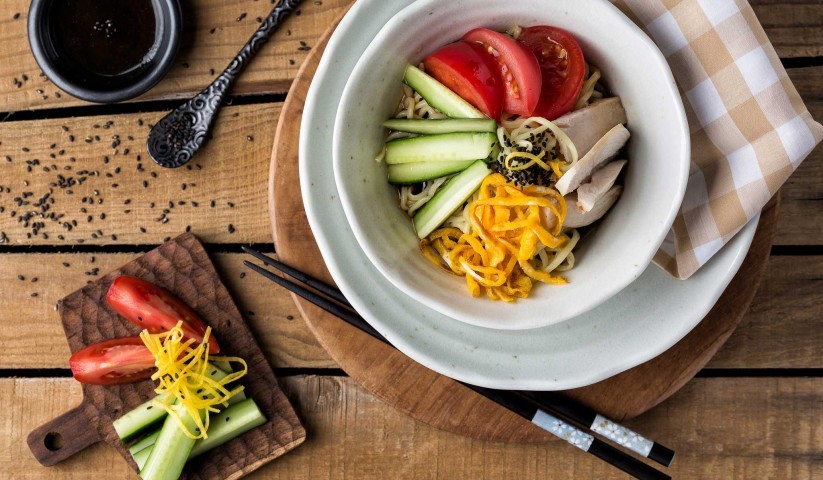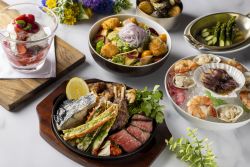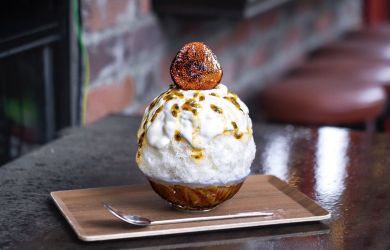
June 12, 2017
Surviving Japanese Summer on Cold Noodles and Eel
How to battle summer fatigue and humidity
By Aleksander Szojer and Anna Jassem
The trademarks of the Japanese summer are the endless concerts of crickets and the unbearable heat and humidity aggravated by frequent rains and typhoons. The Japanese have a special term (mushi-atsui) to describe the steaming hot summer weather, another one (natsubate) for summer fatigue, as well as some fifty words for different types of rain. Summer dishes are therefore meant to cool you down and give you stamina to survive this hottest time of the year.
While other Asian countries deal with high temperatures (and bacteria) by adding spices, the Japanese seek relief in cold dishes. Thus, not only tea and coffee but also any of your favourite noodles — be it ramen, udon, soba or somen — will be served chilled or even with ice cubes. Unusual or even bizarre as that may sound, it’s actually an excellent idea on a hot, sweaty day. Serving the noodles cold also better reveals their texture and unique taste, making them a real treat.
The most popular summer noodles are thin somen, which can be boiled instantly and equally quickly chilled in ice cold water. The favoured way of eating them is as nagashi somen, literally meaning “flowing somen.” You cut the bamboo, let the somen noodles flow with water and catch them with your chopsticks. It’s great fun! Some countryside restaurants offer a more adventurous version in which the noodles are flown down a mountain stream from which the guests fish them directly with chopsticks, to the great joy of children.
For a chilling dessert, nothing beats a local non-dairy version of ice-cream — that is, kakigōri (crushed ice). This treat resembles a mountain of snow topped with fruit syrup or — in a more traditional version — with sweet azuki beans, matcha syrup and small mochi. It’s a must at any summer festival, along with some heavier take-away specialties such as takoyaki (octopus balls), okonomiyaki (savoury pancakes with cabbage) and yakisoba (fried ramen-style noodles with pork and vegetables).
Summer is also the ideal time to enjoy fresh summer fruits (melons, watermelons, peaches) and vegetables (cucumbers, tomatoes, aubergines, peppers). One popular summer game played at beaches and picnics is suika wari (watermelon splitting). Like in the Mexican piñata, the players are blindfolded and try to break a watermelon with a wooden stick. The person who cracks the watermelon open wins and afterwards all participants enjoy eating it.
Another, somewhat surprising, summer specialty is fatty eel. It’s eaten particularly on doyo-no-ushi-no-hi, which is considered the hottest time of the year. Doyo means 18 days before changing of the seasons, and ushi stands for an ox — one of the summer zodiac symbols. The presence of this rather heavy fish on summer menus is linked to a somewhat complicated story tracing back to the Edo period. Legend has it that Hiraga Gennai, a famous 18-century inventor, advised the restaurateurs to market unagi (eel) as an ideal fish to be eaten on a day starting with a letter “u” – ushi-no-hi – in order to help survive the challenging Japanese summer in good health. This was most likely one of the first marketing campaigns in Japan. However, it also has some reason to it, as eating eel indeed does give you stamina to deal with summer fatigue. It tastes very good too.
RECIPE FOR COLD RAMEN – Hiyashi Chuka
Ramen, one of the most popular dishes in Japan, is actually of Chinese origin. The regular version is served in a meat broth that takes hours to cook and is thus eaten almost exclusively in specialised eateries. In contrast, the summer variation, hiyashi chuka (literally “chilled Chinese”) is actually very quick and easy to prepare at home. Chilled noodles are topped with shredded vegetables, egg, meat and/or seafood and served with a delicious vinegary-sesame dressing, making for a colourful, refreshing dish, perfect for a hot day. Additional bonus: you can adapt the toppings according to your taste and what you have on hand.
INGREDIENTS (for 4)
- 4 portions uncooked ramen noodles
- For the sauce:
- 90ml rice vinegar
- 120ml soy sauce
- 4 tbsp sesame oil
- 4 tbsp sugar
- 4 tbsp sake
- 100ml liquid from steaming the chicken
- Garnish ingredients
- For steamed chicken (can be substituted with julienned ham):
- 300g chicken breast or thigh
- 1 tsp salt
- 50ml sake
- 50ml water
- For egg julienne:
- 2 eggs
- 2 tbsp sugar
- ¼ tsp salt
- 2-4 tomatoes
- 2 small, thin Japanese cucumbers or 1 big, thick cucumber (deseeded)
PREPARATION
Prepare the steamed chicken: Place chicken meat, sake, water and salt in a medium pan, cover with a lid and bring to the boil over high heat. Lower the heat and cook for a further 15 minutes. Make sure the chicken has cooked completely at this time. Turn off the heat and let it steam for 5 more minutes. Set aside.
Prepare the sauce: Mix all the ingredients (vinegar, soy sauce, sesame oil, sake, sugar and chicken liquid) in a small pot and warm them up over low heat, stirring well until the sugar is dissolved. Let the sauce cool in a pot, then transfer to the fridge until serving.
Prepare egg julienne: Mix all the ingredients in a small bowl, cutting the egg white to make a smooth liquid. Heat a non-stick pan and apply a small amount of vegetable oil. Spread 1/3 amount of egg mixture into the pan and cook like crepes on both sides. Repeat two more times. Pile the three egg crepes on a cutting board, roll them and cut vertically into thin julienne.
Cut the cucumber in julienne and the tomatoes in wedges.
Cook noodles according to the directions on the package. Once boiled, let the noodles cool under running water.
Arrange cold noodles in individual plates. Top with chicken, egg julienne and vegetables. Pour approx. 120ml of the sauce over each portion.
Hints:
- Leftover sauce can be used as a dressing for fresh vegetables.
- You should be able to get fresh or dried ramen (chuka men) noodles in bigger supermarkets and in Asian stores. Otherwise, feel free to experiment with whatever noodles you have in your cupboard.
- The same goes for toppings. For a seafood version, try shrimps and/or crab sticks and for a vegetarian one — add shiitake mushrooms and/or additional vegetables such as corn, edamame, asparagus, okra, zucchini, broccoli and bean sprouts.
Recipe courtesy by Kisshy from Musubi Cooking Class in Tokyo
This article is adapted from Anna Jassem and Aleksander Szojer’s upcoming book, In the Rhythm of the Seasons: Japanese Customs and Home Recipes.





